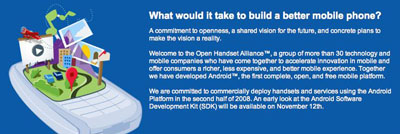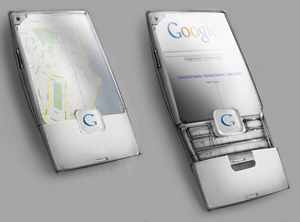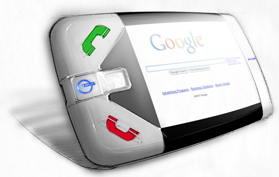Also see: The Gphone is coming; how Google could rewrite the rules
 It’s clear that Google, which announced its entry into the wireless world today, is out to break the stronghold of the carriers in the U.S. to advance their own initiatives — selling mobile ads and getting their applications on as many cellphones as possible.
It’s clear that Google, which announced its entry into the wireless world today, is out to break the stronghold of the carriers in the U.S. to advance their own initiatives — selling mobile ads and getting their applications on as many cellphones as possible.
 As expected, Google did not announce it was delivering an actual branded phone, dubbed the Gphone. Instead Google is leading a broad industry partnership known as the Open Handset Alliance and is developing an open software mobile platform known as Android. Together, Google hopes, these will deliver a new breed of handsets and greatly improve the mobile Internet experience for consumers worldwide.
As expected, Google did not announce it was delivering an actual branded phone, dubbed the Gphone. Instead Google is leading a broad industry partnership known as the Open Handset Alliance and is developing an open software mobile platform known as Android. Together, Google hopes, these will deliver a new breed of handsets and greatly improve the mobile Internet experience for consumers worldwide.
“We are not building a Gphone, we are enabling 1,000 people to build a Gphone,” Andy Rubin, Google’s director of mobile platforms, told The New York Times. (See also Rubin’s blog announcement.)
Eric Schmidt, Google’s chief executive officer and chairman, said in a statement, “Our vision is that the powerful platform we’re unveiling will power thousands of different phone models,” he said.
 The Open Handset Alliance is where Google’s initiative begins. It is comprised of more than 30 mobile operators, handset manufacturers, and software, semiconductor, and commercialization companies.
The Open Handset Alliance is where Google’s initiative begins. It is comprised of more than 30 mobile operators, handset manufacturers, and software, semiconductor, and commercialization companies.
Among the participating carriers are Sprint and T-Mobile in the U.S., the world’s largest telecom operator (China Telecom), the leading carriers in Japan (NTT DoCoMo and KDDI), as well as T-Mobile in Germany, Telecom Italia in Italy, and Telefonica in Spain. Noticeably absent are AT&T and Verizon, the two largest carriers in the U.S. with more than 50 percent marketshare.
Handset manufacturers who signed on are HTC, LG Electronics, Motorola, and Samsung. Obviously those who participate in the smartphone market — Apple, Microsoft, Nokia, Palm, and Research in Motion — are not involved as the so-called Gphones will compete with their own offerings.
The Gphones, however, are not expected to reach the market until the second half of 2008.
Among the chip makers are Broadcom, Intel, NVIDIA, and Texas Instruments. And software is represented by a bunch of companies most people have never heard of, except for eBay (owner of Internet telephony company Skype) and Google.
 The idea here is that the Open Handset Alliance works together to produce components and hardware that works flawlessly with Android, which Rubin originally co-founded before being bought out by Google in 2005. Android is a fully integrated “software stack” that consists of an operating system, middlewear, a user-friendly interface, and mobile applications. (Intro video.) The SDK will be released Nov. 12.
The idea here is that the Open Handset Alliance works together to produce components and hardware that works flawlessly with Android, which Rubin originally co-founded before being bought out by Google in 2005. Android is a fully integrated “software stack” that consists of an operating system, middlewear, a user-friendly interface, and mobile applications. (Intro video.) The SDK will be released Nov. 12.
In contrast to existing competitors, Google’s software will be freely available under “open source” licensing terms, meaning that cellphone manufacturers can use it at no cost and create their own features and apps to differentiate their products and services from others. In return, Google’s mobile strategy is not unlike it’s success on the Internet — give away software and services to gain revenue through targeted advertising.
Obviously, these new Gphones will feature applications and services from Google — Gmail, Gtalk, Google Docs, Google Maps, Google Earth, Search, AdSense, among many others. Additionally, programmers familiar with the Linux operating system and Sun Microsystem’s Java language will use Android to create all kinds of apps and features, allowing consumers to load up their phones with whatever software they want to use independent of what’s already on the phone.
 Currently in the United States, consumers are generally restricted by the mobile operators from putting any software on their phones that’s not offered or blessed by the carrier. This lack of flexibility and the resulting consumer frustration has been a driving factor behind Google’s mobile initiatives from the start.
Currently in the United States, consumers are generally restricted by the mobile operators from putting any software on their phones that’s not offered or blessed by the carrier. This lack of flexibility and the resulting consumer frustration has been a driving factor behind Google’s mobile initiatives from the start.
“We want to create a whole new mobile experience for users,” Schmidt said. “Mobile users want the same applications on the phone as they use on the Internet.”
Peter Chou, chief executive of HTC, one of the largest handset makers in the world, told The Times, “Today the Internet experience on handheld devices is not optimized. The whole idea is to optimize the Internet experience.”
But the “Internet experience” is relatively new to a majority of cellphone users. Internet-enabled phones have been around for years, but these have many factors working against them, namely the small size of the phone, poor browsing experiences, user interface constraints, complexity, and the overall expense of buying a smartphone and using a carrier’s data plan.
This is changing, however, as Apple introduced the iPhone this summer. The iPhone has a large, high resolution, bright touch screen, full email and calendaring capability, and a pleasant Internet browsing experience with Safari. While it’s tied to one primary carrier (a huge sore spot in itself), AT&T at least offers an unlimited data plan great for checking email, browsing the Web, and using Web apps.
Apple and Google are tapping into the fact that consumers depended on the information that’s important to them, no matter if it’s email, instant messaging, chatting, blogging, carrying around PDFs, or logging into social networking sites such as MySpace or Facebook.
The more people are mobile, the more they carry their information with them, the more they participate in social media and social networks, the more they need mobile devices that meet their needs. The iPhone is a start, and the Gphones a continuation.
But this is where the two separate.
Apple is taking the route of a semi-closed environment, controlling the components, hardware, design, and software of the iPhone. Apple initially opened up the iPhone only to Web apps, but that is expected to change in February as third-party developers will finally gain access to an SDK so they can produce new applications and games for the phone.
 Google is taking the open route, which many industry observers and consumers applaud loudly. Without the Open Handset Alliance, it would be a bumpy road — not unlike what Microsoft faces with Windows Mobile on hundreds of devices worldwide. With the alliance, the going for Google and Android is expected to be smoother, but not without potholes.
Google is taking the open route, which many industry observers and consumers applaud loudly. Without the Open Handset Alliance, it would be a bumpy road — not unlike what Microsoft faces with Windows Mobile on hundreds of devices worldwide. With the alliance, the going for Google and Android is expected to be smoother, but not without potholes.
Can different manufacturers, programmers, and third-party developers deliver Google-influenced phones that meet the needs of today’s mobile, info hungry consumer? Or will Google phones be a mish-mash of user interfaces, half-baked applications, spotty networking, and other problems, which seem to plague Windows Mobile?
The world is waiting.
“Just like the iPhone energized the industry,” Sanjay Jha, chief operating officer at Qualcomm, told the NYT, “this is a different way to energize the industry.”
Original concepts: last100 and Lorin Wood.
Photo credit of Rubin: Jim Wilson, New York Times.

i think it will work to let anyone design handsets. not even apple’s design team can beat it.
lets see the user interface. Is Android really an iPhone killer?
Just wanted to say, I enjoyed the article. Great summary.
Google is truly trying to create an opportunity for innovation (that uses their software and portal for content etc.). A very different spin from Apple’s first iphone – but Apple will also end up making money from the Internet services (music +++)
i think it will work to let anyone design handsets. not even apple’s design team can beat it.!!
Hey, very nice site. I came across this on Google, and I am stoked that I did. I will definitely be coming back here more often. Wish I could add to the conversation and bring a bit more to the table, but am just taking in as much info as I can at the moment. Thanks for sharing.
Dai Software
Keep Posting:)